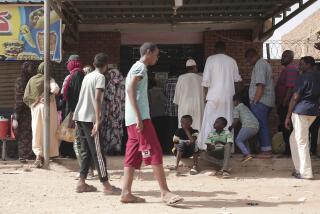Speaking of: The Cholera Epidemic
- Share via
A cholera epidemic sweeping Peru has stricken about 100,000 people and killed more than 600. Peruvian health officials have said that within the next few months, the incidence of cholera could rise to one case for every 100 people in the country from the current rate of one case per 850 people.
What is cholera? * Cholera is a term applied to a wide variety of acute diarrheal diseases of short duration, but particularly to a severe infection of the small intestine caused by a bacteria known as vibrio cholerae , or vibrio comma (because of its shape).
How do people catch it? * They ingest the bacteria, usually by consuming contaminated water or foods. The disease is particularly common in underdeveloped or developing nations where sanitation is inadequate.
What are the symptoms? * After an incubation period of 1-5 days, the sufferer experiences an abrupt, painless and watery diarrhea. This purging diarrhea is soon followed by vomiting, and the patient rapidly becomes dehydrated. The skin becomes cold and withered, the face drawn. Blood pressure falls, and the pulse becomes faint. There may be sever muscular cramps and intense thirst. As dehydration increases, the sufferer may become comatose and can die in shock. The disease normally runs its course in 2-7 days.
How can it be treated? * Antibiotics can shorten the period of diarrhea, and intravenous admission of a sodium chloride solution also inhibits fluid loss and dehydration. When treated properly, recovery can be remarkably rapid. In several large epidemics, there has been a survival rate of 100%. But if the disease is left untreated, a victim’s chance of survival can fall as low as 40%.
How can it be prevented ? * Improved standards of living and better sanitation are key to preventing cholera outbreaks. Immunization is considered only about 50% effective, and protection lasts only 3-6 months.
The social history of cholera * One of the earliest known descriptions of cholera is found in a Tibetan Sanskrit manuscript believed to have been written in the 9th Century. It was described in the Indian subcontinent, in the common delta of the Ganges and Brahmaputra rivers, in the early 16th Century. The disease often rises to epidemic proportions in south Asia, where, for example, it was responsible for at least 370,000 deaths in India during the period 1989-1907. * Cholera was confined almost exclusively to India until the 19th Century, when successive epidemics between 1817 and 1899 spread throughout Asia, Europe, Africa and the Americas. an estimated 6,000 people died of the disease in New Orleans in 1832; 5,000 each in New York and St. Louis in 1847. More than 100,000 soldiers died of cholera during the Crimean War (1853-56). The last major epidemic hit U.S. cities in 1866, although a handful of cases still occur in the United States each year, mainly among travelers who have returned from a visit to Africa or Asia. * Since 1961, a new type of cholera bacteria known as “El Tor” has spread from Indonesia to much of the rest of Asia, Africa, the Mediterranean, the Gulf Coast of North America and most recently--in January--to South America. Ecuador, Colombia, Chile, Bolivia and Brazil have also reported some cholera cases. Nearly 600 people in Zambia have died from the disease in an epidemic spreading through that African nation. And in war-torn Iraq, there are reports of cholera in the south of the country. CHOLERA CYCLE 1. Cholera germs ingested in food or water will incubate in the small intestine for 1-5 days. 2. The germs cause severe diarrhea and vomiting, and the victim becomes dehydrated. 3. The patient may survive if dehydration can be corrected with intravenous admissions of fluid. 4. If therapy is undertaken promptly and no kidney damage has occurred, a patient can fully recover. Sources: Encyclopaedia Britannica, American Medical Assn. Encyclopedia of Medicine, Times Wire Services, Los Angeles Times.
More to Read
Sign up for Essential California
The most important California stories and recommendations in your inbox every morning.
You may occasionally receive promotional content from the Los Angeles Times.













